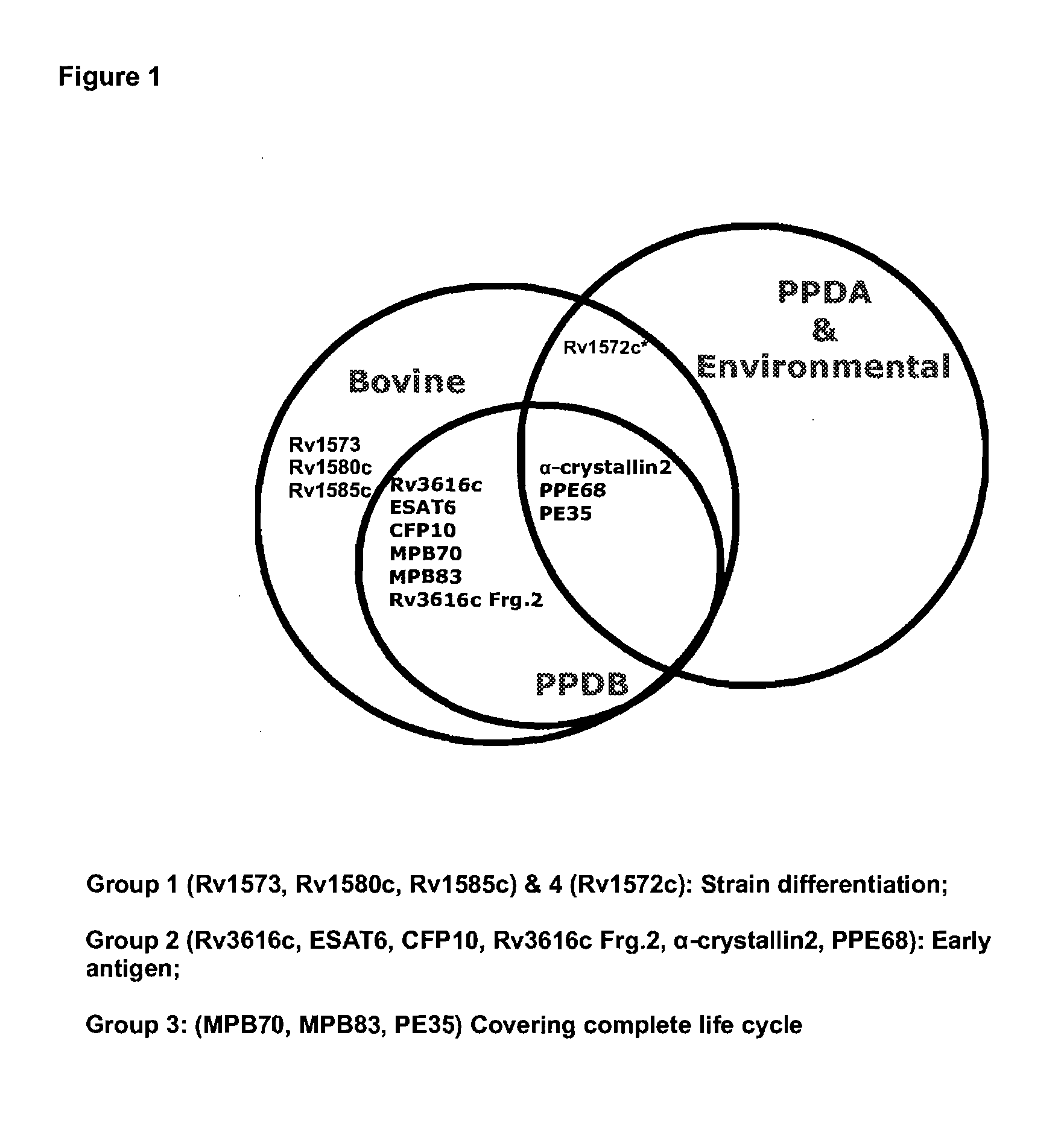Diagnostic method and kit
a diagnostic method and kit technology, applied in the field of diagnostic methods and kits, can solve the problems of inability to reliably diagnose the presence or absence of tuberculosis, low diagnostic accuracy, and low specificity of the current method used to monitor tuberculosis in animals, so as to achieve the effect of strong immune response, improved tuberculosis testing sensitivity, and reliable diagnosis of the presence or absen
- Summary
- Abstract
- Description
- Claims
- Application Information
AI Technical Summary
Benefits of technology
Problems solved by technology
Method used
Image
Examples
example 1
[0163]The inventors have used bioinformatics software to identify and characterise proteins which are specific to one or other mycobacterial strains. Using a genome alignment strategy the group has identified point mutations or deletions which allow differentiation between M bovis, PPD (M. bovis AN5 and M. avium), M. bovis BCG and environmental mycobacteria (FIG. 1). They have identified a panel of proteins capable of strain identification (FIG. 2(a).
[0164]As described below, the inventors have surprisingly found that by using a panel of seven or eight of these antigens, compared to known techniques, the accuracy of detection of tuberculosis may be greatly improved.
[0165]Significantly, a high degree of sensitivity demonstrated using this particular panel of antigens is obtainable across cohorts of tested animals from different geographical regions, giving a level of coverage which is unprecedented in tuberculosis testing.
Methodology
Cloning, Expression and Purification of Mycobacteri...
example 2
Multiplex Assays
Methods
[0203]Serum samples used in the study were obtained from several sources. Blood samples were taken into serum tubes (Vacuette, serum clot activator tubes, Greiner-bio-one), transported at room temperature and then stored at 2-8° C. until processing. Following centrifugation (3000 g, 30 minutes at 2-8° C.) the serum was removed, aliquoted and stored at −20° C.
[0204]Two sets of sera were obtained, one from a negative sample bank including sera from herds of animals with a known history of being free of Mbv. A third group of sera were collected from animals that were proven to be positive for Mbv infection at the time of slaughter based on subsequent histopathological / bacteriological examination.
[0205]The fourth set of serum samples was part of an infectivity study. The animals were non-vaccinated and challenged via the intra-tracheal route with a low dose of a virulent strain of Mbv (approximately 5,000 CFU). Sera were collected prior to challenge a...
example 3
Identification of Panel of Antigens for Diagnosis of TB in Bovines
[0217]The inventors used the multiplex platform described above to analyse antigen expression from 522 cattle, which had been confirmed TB positive by histopathology and culture methods, using 1489 cattle, which had been confirmed TB negative using tuberculin skin tests, as the controls. The inventors identified a panel of five antigens which when assayed together enable diagnosis of tuberculosis infection with very high sensitivity and selectivity. The assaying for the presence of at least two of the five antigens ESAT-6+Rv3616c+pep1 (MPB70)+MPB83+MPB70 gave a sensitivity of 93.7%, compared to 71.4% obtained with ESAT-6+Rv3616c+pep1 (MPB70)+MPB83, 25.5% obtained using ESAT-6+Rv3616c+pep1 (MPB70). The specificity obtained with ESAT-6+Rv3616c+pep1 (MPB70)+MPB83+MPB70 was 97.6%.
PUM
| Property | Measurement | Unit |
|---|---|---|
| volume | aaaaa | aaaaa |
| volume | aaaaa | aaaaa |
| volume | aaaaa | aaaaa |
Abstract
Description
Claims
Application Information
 Login to View More
Login to View More - R&D
- Intellectual Property
- Life Sciences
- Materials
- Tech Scout
- Unparalleled Data Quality
- Higher Quality Content
- 60% Fewer Hallucinations
Browse by: Latest US Patents, China's latest patents, Technical Efficacy Thesaurus, Application Domain, Technology Topic, Popular Technical Reports.
© 2025 PatSnap. All rights reserved.Legal|Privacy policy|Modern Slavery Act Transparency Statement|Sitemap|About US| Contact US: help@patsnap.com



